It has been a really, really, really long time since I have been so excited, almost giddy, about a conference experience. Maybe going back to the first Open Education ones, or better yet, to the Northern Voice conferences 10 years ago.
Perhaps I wrote conferences off, but last week’s Digital Media and Learning conference held on the campus at University of California Irvine flipped that assertion off. While I did enjoy going to the DML conference last year in Los Angeles, but coming from from this one I felt different, almost electrified (so much I first wrote this post with a gazillion typos, now it may only have a zillion). So it makes me wonder what is that essence that does makes the experience so exciting? I can guess. It’s a combination of things that maybe you can only glimpse at in hindsight.
Being there did get me thinking to some of my first conference experiences. There was always the excitement about the travel, but then I focused completely on the program schedule, checking out the details on the keynotes and figuring out what sessions sounded interesting. But meeting people was soooooo awkward. It meant speaking to strangers after some mutual glancing at the name tag. This was pre-smartphone (the technical pre–Cambrian era), so I might pull out a laptop to look like I was busy (aka reading email). Or actually really early on, we would line up at computer kiosks … to read email.
It changes everything having connective experiences with people before the conference via networks, be it social media, blogs, doing hangouts together. When I saw someone like George Station, whom I never met in person, we had lots to talk about right away.
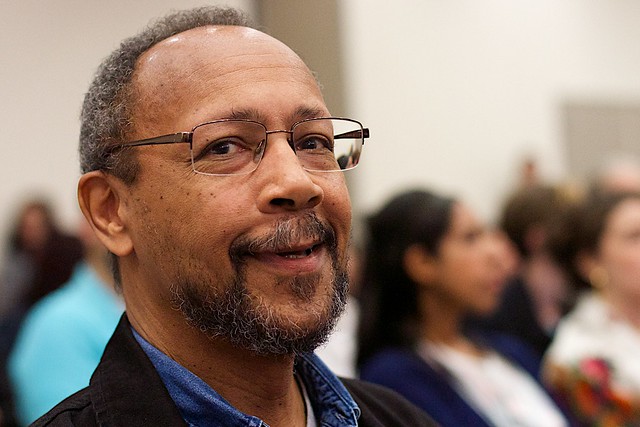
flickr photo shared by cogdogblog under a Creative Commons ( BY ) license
Spending time together in person just mutually enhances both kinds of connection.
Or there is Jane Van Galen, whom I really know only through twitter as @jvg and some pass crossing via DS06 but I do know now she works with my good friend Todd Conaway who recently took a job at the university where Jane teachers. I could rattle off 10 more examples, but this is already going to be a looooooong post.
Unlike my early conference experiences, I found now the sessions and the program are almost incidental to everything else in the spaces between. Like saying “hello” to a person waiting with you in the coffee line. “Where are you from?…” This happened meeting Russell in line at In N Out Burger, who does amazing work at the Holocaust Museum. A passing joke at a table over the precious wall outlets with a young woman (yikes I forgot her name) who smiled saying something like “it pays off to be nice”, starting a round of “where are you from”, turning into meeting Evan who is from Arizona State University. Or when you end up at a dinner table with people you don’t know, and getting into a great story exchange of “How I got into computer science” with Morgan (she was an astrophysicist who needed to compute!) or… yikes, here come all the stories.
A conference now to me is a huge potentially serendipity engine that plays off of, and amplifies, the valuable of connections in the online space. But not on its own. Not just by going to a conference. You initiate a things.
That’s my seven paragraph introduction. In the “old days” I might have been blogging every session I went to, here I am now with one giant über post of highlights. So here it goes in pretty much chronological order, knowingly I will miss out on huge chunks,
Crafting Connected Courses Pre-Conference Workshop

flickr photo shared by cogdogblog under a Creative Commons ( BY ) license
The workshop I did with Justin Reich has been blogged here already so I won’t re-hash it. Much. We had about 17 participants, and the best part was hearing, from our opening “interview each other” session, what the range of interests were, far being “courses” or higher-ed only.
We pushed them hard, and they kept with us., I packed more into the materials then we covered, but all of it is hanging out there for anyone else to play with, reuse at connectedcourses.stateu.org. A big thanks to Reclaim Hosting especially Tim Owens here for working with me on the setup.
I did an 8 hour commercial for them today at #2016dml To be blogged… https://t.co/qQ36epidLp
— Alan Levine (@cogdog) October 6, 2016
Maybe this is what got me started with good energy at DML. Being with a group of interesting, enthusiastic, but also questioning, people for a full day? How often do we get to do that back where we work? I’ve not delivered a workshop since February, so maybe I had a surplus of adrenalin fused enthusiasm, but I felt almost off the hook with unhinged energy. I was a tad irreverent and sarcastic. But wow, was it ever fun (well I have little idea of it was mutual, but it seemed so).
Me? Excited About a Keynote?
I am admittedly a bit jaded on keynote presentations (unless I am giving one) (and I have not had an ask since June 2014, so…). I enter them with pretty low expectations. I do like to sit near the front so at least I can try for photos. I’m marginally aware of Constance Steinkuehler’s work in games– my one experience listening to her speak was when I working for at NM. We had her as a keynote for an online conference… when we were doing them in Second Life.

flickr photo shared by NMC Second Life under a Creative Commons ( BY ) license
While I do understand how people see value, possibility in games for/in learning, it has not been a strong interest of mine. I may not have even read the abstract for What is the Intellectual Culture of Games? and would guess it was ‘Games… research… literacy… studies…’
Did my world get rocked?
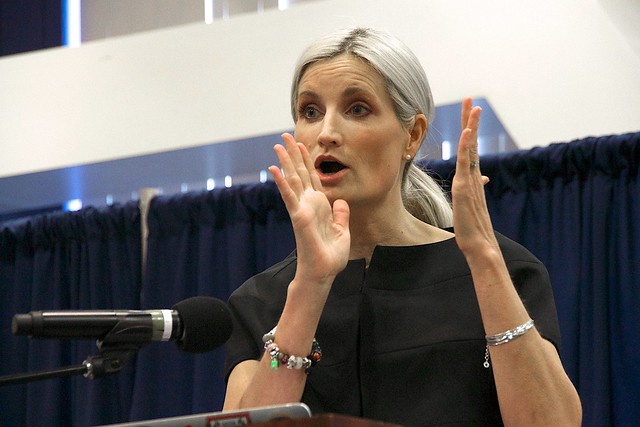
flickr photo shared by cogdogblog under a Creative Commons ( BY ) license
I’m not going to recap since you should just go watch the recording yourself. But to coin a phrase she summarized a “massive” amount of career research that sliced way deeper than the typical media summaries of “games are bad for us!” “games will change everything” — really sensible insights into what literacies are really elevated from not just the games themselves, but asking questions of context.
That was interesting, but it was really the latter part where Constance moved to the societal impact of technology in education, the old images of kid in a class watching TV as reifying a mono culture, and really hammering that hard question of how education is part of a privilege “gamed” system that perpetuates a treadmill of young black men into jail. Yes, she called out the race issue. And challenged education to maybe put 10% of their effort into really doing something about it (I am paraphrasing somewhat from memory). I feel reverberations.
The second standout message was from her experience as a White House advisor in education, how she saw the work as an endless series of meetings, and making intros. But it was her framing of how we should not be trapped into the belief we cannot change it, that change is “not done be executive memos from the top” but how a relatively small number of people, organized, can leverage the communications channel.
So many people were tweeting the best bits, all I could come up with was “Wow”
Everybody's getting the great quotes, I just want to say @constances is awesome #2016dml
— Alan Levine (@cogdog) October 6, 2016
I don’t know if I can really explain it, but this was the first keynote in a while I was leaning forward from the edge of my seat. And maybe it was her low key, personal presence, making light of a few times she lost track, and the off the cuff reference to the current political situation. But in all of her talk, she radiated an energy of whol body enthusiasm. It reminded me some of when I first heard Jane McGonical at SWSW in 2008– the thing I remember the most was McGonical was so excited to share that literally her body was bouncing, almost dancing. I’ve seen too many stiff corpses on the podium.
Not at DML.
Fun Things Happen When You Choose a Random Session

flickr photo shared by cogdogblog under a Creative Commons ( BY ) license
In contrast to my first conferences where I tried to pick sessions of interest based on titles, often I try a counter-intuitive tactic. I pick one either randomly, or one that might be my last one chosen on basis of interest, or one where I know nothing about the presenters so I can maybe expand my network. We can miss out when we stay only in our cone of interests.
The real reason I walked into the room for Get Creative with Coding: Dance, Sports, and Other Interests? I was eager to say hello to Gardner Campbell and catch up. He was in the room. Heck I sat down next to him not even know the topic of the session.
This one was about Scratch, a technology I again have a surface awareness of, but never really took even a shallow dive. But this one specifically was on their Coding for All project. At first glance you might think by this name that it is another GLORY BE TO CODE, ALL PEOPLE MUST CODE, but it’s more than coding for the sake of coding… well let their site say it:
The Coding for All project brings together an interdisciplinary research team from the MIT Media Lab, the Digital Media and Learning Hub at University of California Irvine, and Harvard University’s Berkman Center for Internet and Society to develop new online tools and activities to engage more young people in developing computational fluency, particularly youth from groups currently underrepresented in computing.
“Computational fluency” may be taken as fluent in computers, but I read it in being able to use those things for larger purposes.
The session was really about getting experiences with Scratch Microworlds (I cannot find a general link, but in the session I followed a handout link for one with musical instruments). So Scratch is this visual programming language, with variables, loop, logic structures, event driven actions, etc. But jumping into Scratch itself opens the door to a lot of things to fiddle with. All much too many at once for a new users.
So Microworlds bring people into a technical environment, but via a smaller entrance step.
The concept of a MicroWorld is it starts set of “sprite” objects and a reduced set of Scratch tools. Not a blank screen and All The Tools. It encourages you to start clicking things together, and seemingly in a way that leads you, after getting a few things to make noise or animate, to explore the capabilities just under the hood (e.g. changing the menu options for actions). But eventually you run against its limits, and then you open the project in full Scratch.
I am sure there is an edu-academic term for this. Scaffolding?
Anyhow Gardner and I both started poking with the musical instruments and talking as we figured things out. I’m a bit more aware of the idea of events as drivers of screen action (e.g. do something when it is clicked, or when a key is pressed), and pointed them out to him, but he figured out the feature to record a sound and then use that as a sound effect (as well as other advanced audio tools), and showed it to me.
I love that DML designed these hands on sessions as 90 minutes. And that the presenters (in this one at least) set us loose very quickly into hands on exploration. And most DML sessions are led by multiple people.
The room kind of erupted with sounds and shouts of glee.
We had about 30 minutes of open discussion at the end. I noted the amplification power of us doing this physically in the same space, the way we feed off of each others energy, and naturally turn to the person next to see what they are doing or to show what I learned.
But what I am left with is the power of coding as a means to express and do something, not coding for coding’s sake or to get some badge.
And I left with a brimming amount of joy for getting this much out of a session I normally would have walked past.
Hanging Around a Virtually Connecting Session
We had a number of Virtually Connecting things happening at DML. The June 2015 conference was one somewhat early in our first year of doing this. That seems like a long time ago!
There can be a bit of uncertainty at the onsite end. Sometimes, the people we work with are able to schedule us a room, but other times we just have to scout a location. Claudia Sullivan from DML knew of our schedule, but the site does not have many, if any meeting rooms. She did suggest one unscheduled room set up as a charging station. For the first one we had planned, where Mia Zamora was the onsite buddy, I wanted to be available to do tech support.. and just watch.
But the room we wanted to use was packed with people and noisy! So we quickly convened to a session room (this was the 30 minutes at the end of the lunch break), and we eventually got booted out. Our onsite guests with Mia included George Station (he may have crashed), Kate Green, and Christian Friedlich. We had all rushed back after grabbing our In-N-Out burgers, and you can see how animated they were.
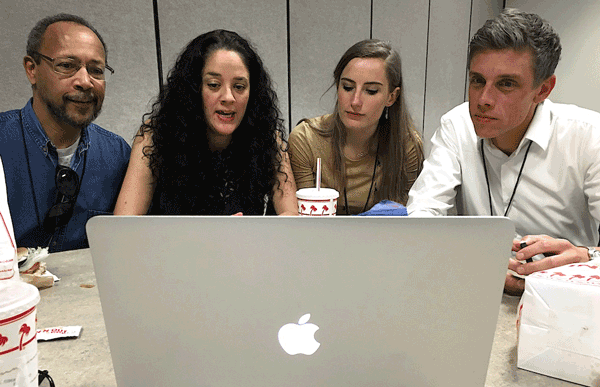
A very chatty animated crew!
You can watch the full recording, I feel bad that Christian did not get many words in (but he sure did later that day in the ignite talks…) I did not have a role here, I just wanted to be around for support.
I did like the way Mia came in with a question that pushed the first bits of conversation from reporting on sessions to a richer level.
Sometimes You Just Sit Around a Table and Good Stuff Happens
I may have my timelines crossed, but I think we all went outside for a breather after our session. Or maybe it was later in the day. Mia and I planned to talk, because over the summer we had started plans for working on an open course/experience with DML on narrative that originally was going to start in August as a leadup for the conference.
When things do not happen, it can be fortunate. we both ran short on time, as did our DML contacts, so we decided to aim for after the new year. But Mia and I wanted to pick up our brainstorming.
Well, it was idea, after idea, and we got so excited (and probably loud) a few people wandered over to ask what the heck we were talking about. After explaining most were like “I want in!” Mia and I had another conversation like this the next day, and just out of a casual conversation with Remi Kalir the day before, another possibility clicked in.
Yes, I am being vague.
On purpose.
You will just have to wait.
All I can show you is a box of fries that have nothing to do with the project. Nothing.
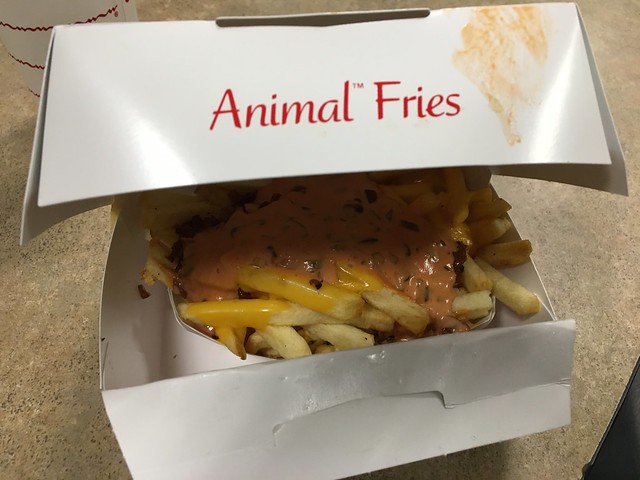
flickr photo shared by cogdogblog under a Creative Commons ( BY ) license
Presenting in Hybrid Mode about Virtually Connecting
I was also part of a 30 minute (that is fast!) presentation Virtually Connecting as a Model for Transformative Learning with Mia Zamora and Andrea Rehn on site plus Maha Bali, Rebecca Hogue, Nadine Abdoulmag, and Autumm Caines coming in virtually.
Lots of things could go wrong with all the variables in doing this, especially the unknowns of shared wireless network access, and we always worry about audio feedback.
We had a few weeks of back on forth on the way to run this presentation. Someone suggested slides, and I pushed back some “why do we need slides? can’t we run this conversationally, like we do Virtually Connecting?”, but in the end… I was wrong. The slides turned out to really help pace us. I could not help myself but go in and dress up the slides. If you are going to do slides, IMHO, make those photos full screen.
There’s a lot to consider when presenting to a room with some presenters coming in via Google Hangout. There is worry about audio feedback. Fortunately it was a small room, and there was no microphone. But the wire for house sound did not connect, and by the time a media tech showed up, I had pulled out my little emergency backup speakers.
But more than that, how can this be done with one projector? We had the Google Hangout so the audience could see and hear the virtual speakers, but how to show the slides?
My approach was to screen share the slides in the hangout, and then, as the initiator of the hangout, do some swapping of camera views from mine (the slides) to Maha, Rebecca, Autumm, and Nadine when they spoke. For speakers in the room, I left the slides on the view. So I was kind of directing shots at a sports event.
There is a trick when using Google slides. You cannot do normal presentation view, because when to goes full screen, you lose access to your Hangout. What works is to open the slides in a new window, and use the option under Present for Presenter View.

A controller pops up in one window, and the slides play, but only filling the window, not the screen. In the Hangout, I use the Screen Sharing tool, and select the window that my slides are in.
It did work, although there is a bit of delay while I move the hangout to the slidedeck to advance the slide. But I think it worked pretty well, I tried flipping the camera view a lot, and also stepping through the faces of the other virtual folks while another was talking.
And here I have been talking about the tech and have not ever mentioned the talk. I thought we did well to have seven speakers talk in 30 minutes, plus we had time at the end for a few questions/comments.
Virtually Connecting Hangout Number Two
We scheduled another Virtually Connecting session after our presentation, with the idea anyone interested could watch us run a “regular” one, kind of fishtank mode.
Perhaps we did not communicate it clearly, or the end was rushed, or they got all they wanted, but no one showed up beyond the guests we were expecting. I do take any photos, but know it was a fabulous talk with Kim Jaxson and Jonathan Worth (Gardner Campbell popped in too). Helen DeWaard was our virtual buddy host, as usual running things, and calmly, to a very smooth level.
He heard about sessions on Maker spaces and had some stories of those sessions when the audience is really really really tiny (I recalled one conference where I was the whole audience) (and the session was brilliant). Jonathan went on a grand riff about his struggle to use session’s framing of “brokering” and “leveraging” in the context if networked relationships.
It was good conversation, as always it is in Virtually Connecting. Check it out!
Igniting the Ignite Talks

flickr photo shared by cogdogblog under a Creative Commons ( BY ) license
I love how DML ended both days with rounds of Ignite talks, the timed slide advancing ones that are crafted to expose an audience to a lot of ideas in a short period of time. And is fun.
These were great talks, you can watch them all.
But the photo above is something I alluded to a few people on site and later in twitter- the role Gardner Campbell played in being more than an emcee, but a host. The Ignite host typically aims to rev up the crowd. I remember last year there was some guy who did it who was loud… but just loud. I am not even looking it up to see who it was, and sorry Dude if I offend you. But that bit of emcee action seemed more about the emcee, the way I saw Garner work, it was to elevate the presenters, not himself.
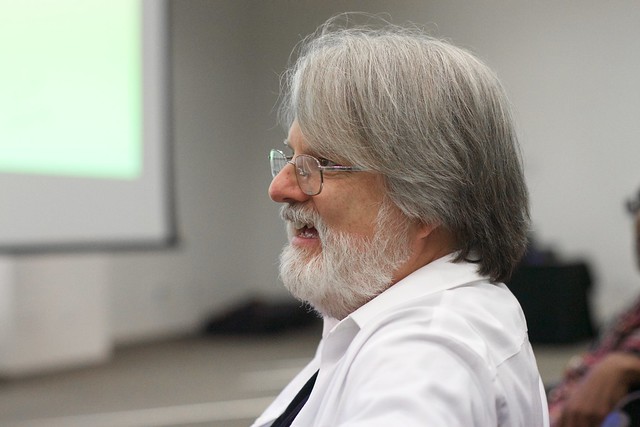
flickr photo shared by cogdogblog under a Creative Commons ( BY ) license
I did not listen in to what Gardner said to his “crew”. I just watched the energy as he was talking to them. You may know that Gardner brings a “show” sensibility to something like this- he has done radio, he has done theater, he has done his own crowd moving keynotes. I imagine for most Ignite speakers, if not all, this mode of presenting is even more nerve wracking then just talking in front of people. There is the pace, and needing to get on and off stage fluidly, and “OMG what if I mess up!”. Robin DeRose whispered to me, “I hope I do not throw up” (she did not).
So again, I do not know what was being said (that is Gardner’s blog post!) (cough!) (cough!), but it appeared he was encouraging, getting them to be both calm and excited. He brought people together to rally over this thing they would do individually, but also collectively. My hunch is, normally, Ignote speakers are left to sit there and just dwell on the pressure and how nervous they might feel. But here, as far as I can see, he did something to make them get out of that space, together as a group. Look at their expressions:
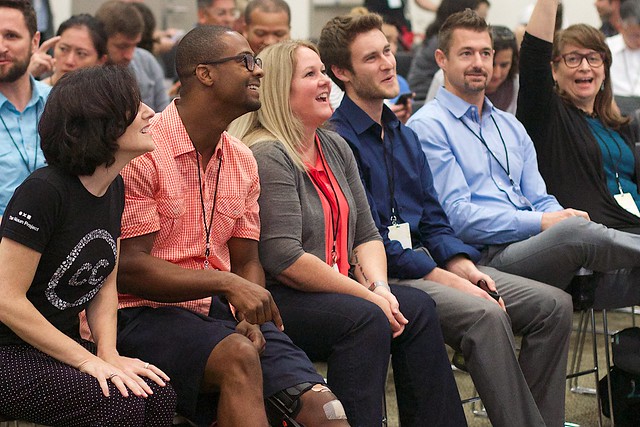
flickr photo shared by cogdogblog under a Creative Commons ( BY ) license
This was all before the camera went on. Gardner did pull out a “thing” where he tried really really really hard to get an audience full of tired, most introverted educators to stand up and dance. Dance. In public. Maybe half to three quarters took part.
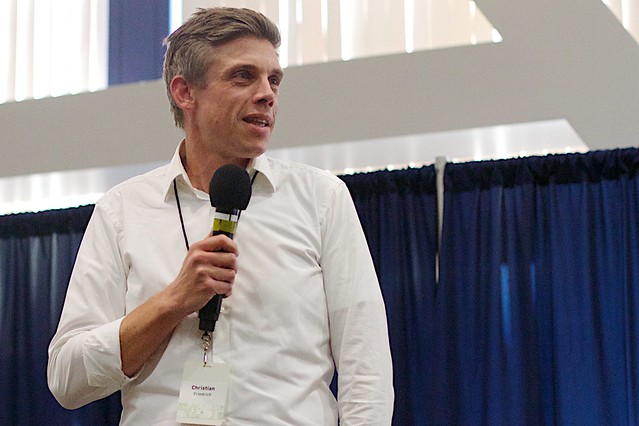
flickr photo shared by cogdogblog under a Creative Commons ( BY ) license
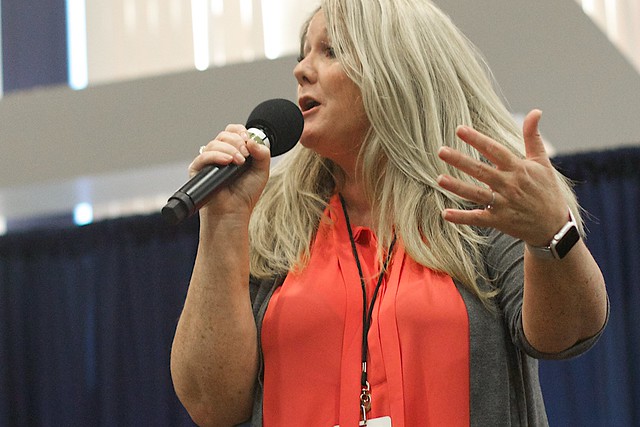
flickr photo shared by cogdogblog under a Creative Commons ( BY ) license
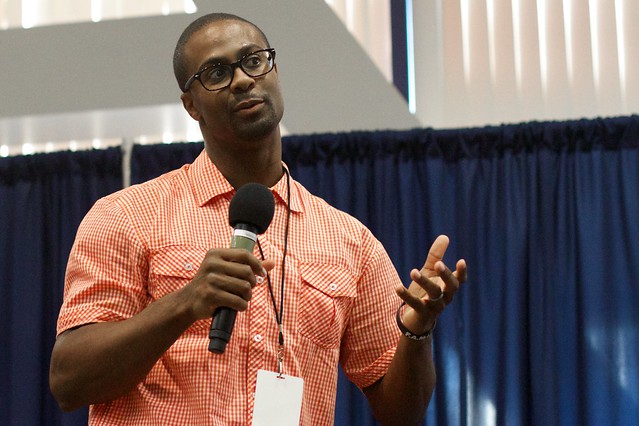
flickr photo shared by cogdogblog under a Creative Commons ( BY ) license

flickr photo shared by cogdogblog under a Creative Commons ( BY ) license
The talks were fantastic, but to me, it was watching this part develop, was even more special. And this was just day one…
Another Day, Another Virtually Connecting Session
This one was again one that was not mine to run, it was Robin DeRosa’s. But Mia and I were continuing the discussion of our Big Idea, and we took the same room they were using. Talking loudly again.
A lot of people were wearing their Hypothes.is shirts this day…
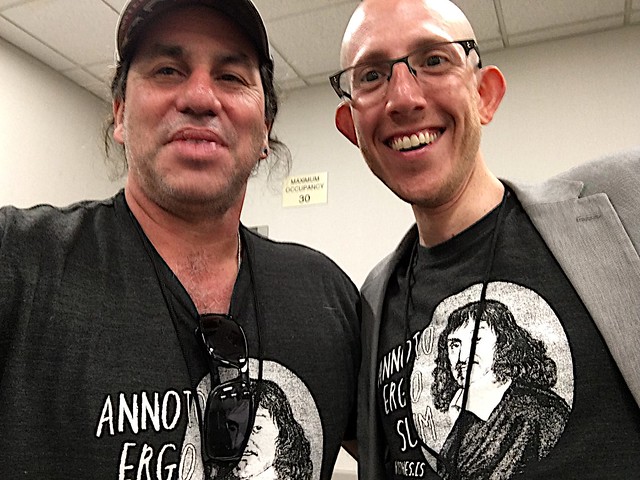
flickr photo shared by cogdogblog under a Creative Commons ( BY ) license
Here is where those small conversational bits leap up. The night before at dinner I was catching up with Remi Kalir, he spoke of his recent wedding, and then I was asking what his wife did (it’s cool). And today, what he told me plugged right into The Project in a Big Way, and then as Mia and explained it, Remi got more and more excepted and roped in (and it would have continued if the Victual Connecting session did not have to start).
But this small bit reminds me of the sometimes complex yet wonderful way the online connections can grow unexpectedly more valuable in person, and then back out again.
I stayed only long enough to capture a photo…

flickr photo shared by cogdogblog under a Creative Commons ( BY ) license
That’s Robin DeRosa hosting with guests Nicole Mirra, Remi Kalir, Jeremy Dean and Joe Dillon. It’s watchable at
The Conversation: Starring Henry Jenkins and Jose Antonio Vargas
I really enjoy the switch from the main session from a one person keynote to the conversation style of Digital Dreamers: Jose Antonio Vargas talks with Henry Jenkins. Literally, the two of them on stage in easy chairs, chatting.
This also took me back to that 2008 SXSW I was at, and Jenkins was in a conversation format then with Steven Johnson talking about the complexity of narrative in shows like Lost and The Wire.
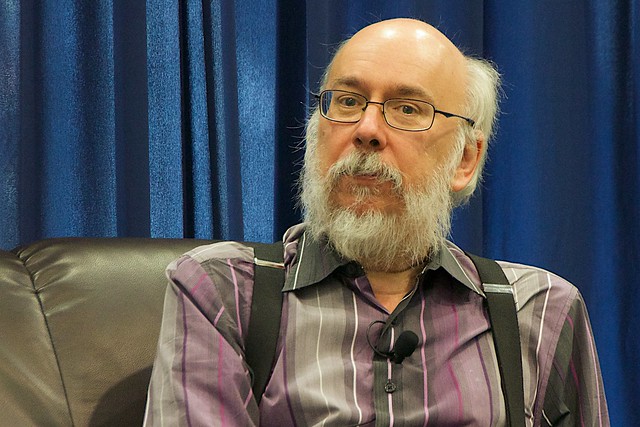
flickr photo shared by cogdogblog under a Creative Commons ( BY ) license
Henry Jenkins makes for interesting photos because of the intensity of his face, which is of course, overwhelmed by what he has to say. I honestly admit not knowing anything about Jose Antonio Vargas — until today.

flickr photo shared by cogdogblog under a Creative Commons ( BY ) license
Sent to the US by his mother at age 12 from the Philippines, Vargas worked his way into journalism at the Washington Post, doing eventually election coverage. He talked about recognizing in the early days of social media, when Facebook, YouTube were relatively new, that he saw many undocumented people “outing” themselves in these spaces. It provided a way to assert their placeless place in America. Vargas was dealing with his own situation that he kept hidden.
So he outed himself too, digitally, as a dreamer. And then he spoke of the long road to earn a “documented” status and asked a question I’d never thought of– for everyone born here, what do we do yo earn our documented status?
The answer is of course, “nothing” we do not have to. It’s baked in. I got a whole list of sites / Vargas documentaries to dig into now.
Like Define American a site aimed to use “the power of story to transcend politics and shift the conversation about immigrants, identity, and citizenship in a changing America.”
And the new site for #EmergingUS that is aiming to help America see it’s future:
We’re used to conversations about race in Black and White, but a new America is emerging: one that is more multi-ethnic, more immigrant, more colorful than ever before. 55 percent of the total U.S. population growth of the last 50 years is due to Latino and Asian immigrants, according to Pew Research Center. Immigrants and their descendants will constitute 88 percent of overall population growth in the next 50 years. At an unprecedented time when White Americans are an emerging racial minority?—?and the movement for Black lives has galvanized millions?—?immigration, yet again, is at the root of America’s transformation.
But the public space where we tell our stories?—?the news media?—?isn’t keeping up. And, too often, when these stories are told, they lack the necessary nuance and context.
As our country’s demographics shift, we need to change the way we talk about ourselves. We need to change the language and images we use to tell our stories and frame our narratives.
This brought home an image I had from my first day in Irvine. The lady who owned the Airbnb I stayed at suggested a nearby international supermarket as a good place for lunch (she was right). She had told me it was owned by Iranians, but catered to a wide range of cultures- Chinese, Indian, South African. As I sat outside eating my gyro, surrounded by a lot of brown faces, speaking both English and other tongues, the obvious set in. I’ve of course heard it. But I was seeing, and among what America is going to be like in a generation or two.
And the America of the Republican election is a fleeting demographic, much as they might hate it (I don’t).
Yes, I know. Duh. I knew this, I read of it, but sitting in the middle of it in Southern California… really brought home how much change this country is in for.
But Vargas comes at from a holistic view. He expressed some caution about some situations where he suggested people may reach for the racist accusation to quickly. And so he sough to understand white America through a documentary (I have it cued but yet to watch)
There was a lot more to this conversation (and I have left out all the stuff Henry Jenkins said, that is a sin of omission) (Later) — I remember this video Jenkins shared about the identification of Superman as an “undocumented alien” a fantastic remix of pop culture into an important modern context.
It’s out there to watch.
But again, both main sessions of the conference, to me, went out of the park. In a good, ridiculously not fitting baseball analogy way.
But Wait, There Were More Ignites
The Ignite sessions on day two were as powerful as day one. I saw the similar before coaching efforts by Gardner (less effort to get us dancing, probably to many people’s relief). This post is going on way too long, so I don’t have much commentary, except again, I was “blown away” by the variety and intensity of the talks. Remi Kalir set the pace strong with an affirmation of annotation. A white guy rapped about teaching kids with shows the Fresh Prince of Belair era to an incredibly brave person reveal and call to action by Kate Green.

flickr photo shared by cogdogblog under a Creative Commons ( BY ) license

flickr photo shared by cogdogblog under a Creative Commons ( BY ) license
I took a lot of photos of Nick, for some reason, which of course, lends itself to GIFdom…
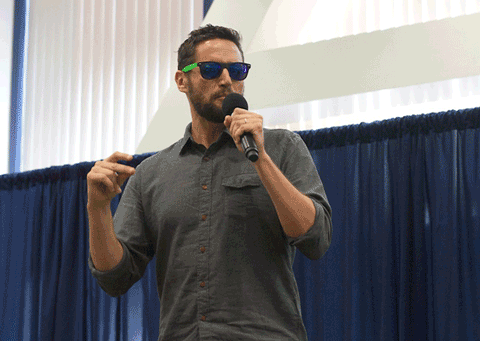
Nick Ross, the Fresh Prince of DML Ignites

flickr photo shared by cogdogblog under a Creative Commons ( BY ) license
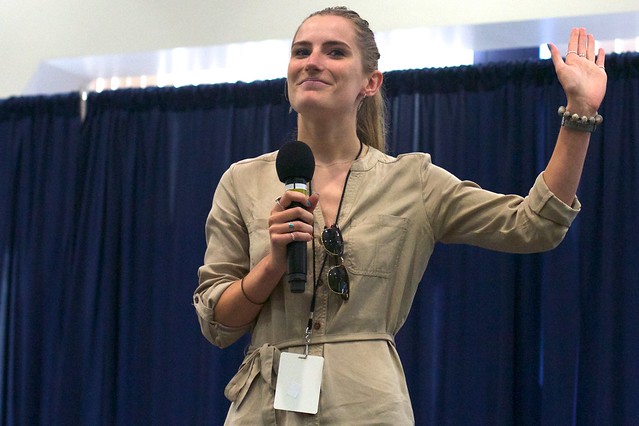
flickr photo shared by cogdogblog under a Creative Commons ( BY ) license
And look how well they move together! The audience had fun indeed, but can you guess what their experience was like?
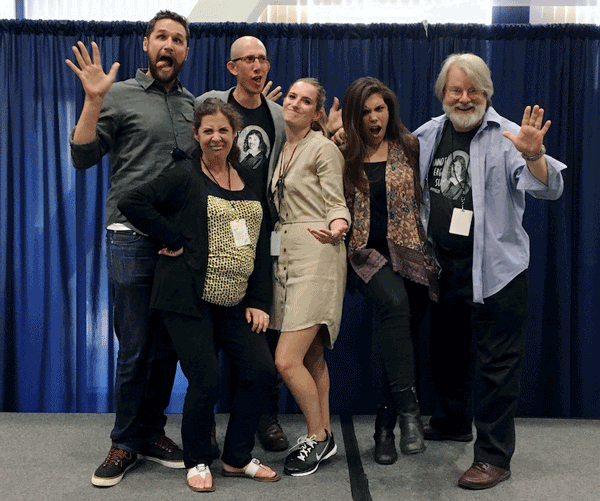
And Then What?
After this long brain dump, I perhaps wonder if I have even come close to communicating what the event meant to me. How does a conference experience jump over the ordinary? I can just hypothesize. Having one is not guaranteed just by going, it’s also what you bring, what you are open to trying, listening, extending… well yes, I am making up a list.
As I have had these peak experiences before, I also wonder how that in-person level of energy can flow into, or be picked up post conference.
And there is a plan being hatched out there that might try.
Stay tuned. The wire is vibrating…

flickr photo shared by cogdogblog under a Creative Commons ( BY ) license
Top / Featured Image: The sign in the registration area at the DML 2016 conference. If you look closely you will realize that it is made of lego pieces, a lot of lego pieces. That is the craftwork of DML’s Jamieson Pond aka “One Cool Guy”. This is my flickr photo https://flickr.com/photos/cogdog/29517417574 shared under a Creative Commons (BY) license


Alan,
I thoroughly enjoyed this jumping blog post. The Holy Fool is the hero who journeys through the path of the Tarot, and he is most successful, most at one with the energies of the unseen world when he is throwing himself into the moment, paying attention to such sidewalk oracles as random choice and serendipity as you did inside the journey room of this conference. You are vividly, explosively centered in your world and work now.
That Kafka quote comes to mind right now:
“You do not need to leave your room. Remain sitting at your table and listen. Do not even listen, simply wait, be quiet still and solitary. The world will freely offer itself to you to be unmasked, it has no choice, it will roll in ecstasy at your feet.”
On a textual note, I appreciate your interplay of media in this richly layered post. You put gifs to work in context, which is goofy but fun–they add visual dynamism to your page and bring a bewildered smile as the reading eye passes by and moves on.
Only one question: where do you kennel Felix when you’re gone, and how is he doing with that separation anxiety you blogged about earlier?
Thanks Sandy for the thoughtful words, Kafka quotes, and even some GIF appreciation. I got the Sandy trifecta!
To answer your important question, Felix has not gone to a kennel since I adopted him. I have a local friend who does work where she is home half the time, and her elderly Mom and video game loving son are there. Felix is fine as long as he is not left alone, even other dogs can be comfort enough (I am NOT going down that route). I’m still trying to deal with it by very small time periods where I leave him inside. He does not go on a berserk tear, he just cries and howls.
I realize I avoided addressing content, which was fun to read, but as an edtech retiree, most of that has slipped away from my focus of attention and interest. All the interests and passions I had as a kid have Bretzed back in, sending my professional interim life down into the flood plain to layer up in sediment–heaviest stuff at the bottom. Time is applying pressure but too soon to petrify–anyway, down there in the flood plain, things are more likely to disambiguate and wash on down to the sea. Gif THAT, #ds106 boyz and gurlz!
I can’t top this as a summary, and I concur with your take on the entire event from workshop to closing session. So I’ll share your post and say thanks for the honorable mention above. BTW I didn’t crash that Virtually Connecting session (there is a “paper trail” of the scheduling somewhere) but I was indeed a few minutes late, so it looked like a crash. At least Mia was willing to move her In-N-Out leftovers and let me sit there. 🙂
Thanks George, I enjoyed hanging out with you in person. Yes, you had your “papers” it just makes for better copy to tweak the facts. I knew you can handle that!